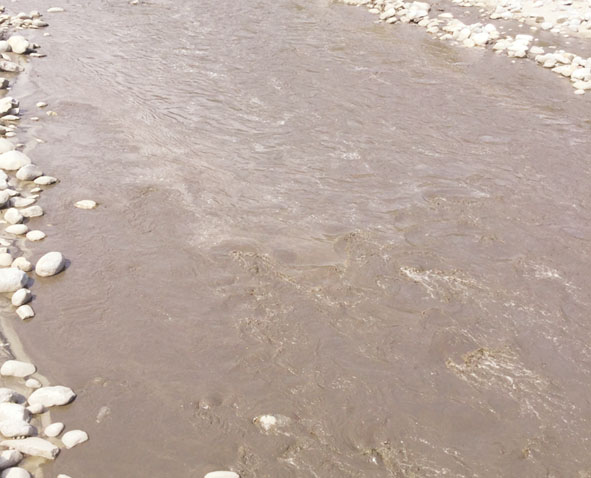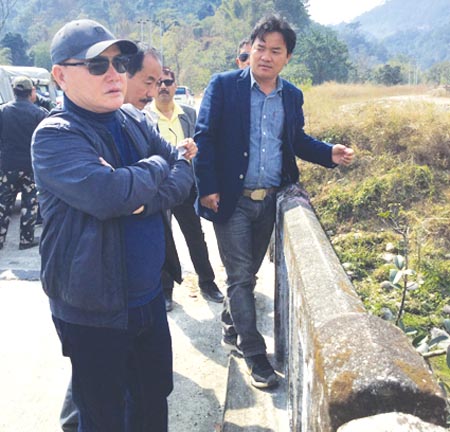Downstream has been damaged: Rebia
[ Tongam Rina ]
KIMIN, Feb 15: The chief managing director (CMD) of the NEEPCO has been summoned by the state government after the Panyor (Ranganadi) river downstream of the 405 mw Ranganadi hydroelectric project (RHEP) turned extremely turbid following the start of maintenance work at the project located in Yazali in Lower Subansiri district.
Environment Minister Nabam Rebia during a meeting with the RHEP’s Head of Project (HoP) P Burman in Yazali on Friday said the CMD has to visit the area within the next one week to answer why the river has turned turbid in the downstream, and to address the concerns of the downstream people over ecological destruction.

The shutdown of the RHEP for maintenance began on 9 February, following which the downstream of the Panyor turned turbid, resulting in loss of aquatic life. In the entire downstream stretch, fishes have turned up dead on the banks of the river, while domesticated animals that depend on the river are not seen in the area.
The minister, who visited the downstream of the river before the meeting, wanted to know the remedial measures from the NEEPCO authorities.
The NEEPCO authorities had no answer to the minister’s question but said the concerns of the people would be passed on to the higher authorities.
Rebia said the NEEPCO has to explain to the government of Arunachal and the people why curative measures were not taken before the plant was shut down for maintenance.
“The downstream has been damaged,” Rebia informed the NEEPCO HoP.
Intriguingly, no one from the NEEPCO has visited the downstream areas after the maintenance work started.
“There is acute technical lacuna, and the NEEPCO should have anticipated that the downstream would turn turbid,” the minister said.
He also questioned the NEEPCO as to why a dumping site was not finalized before the maintenance work started.
The shutdown started before the finalization of a dumping site.
HoP Burman said the radial gates were opened on 9 February, and that they had not anticipated that so much silt would go with the water as the plant was maintaining the natural flow of the river.
He assured that the turbidity would not last long, but it failed to convince the representatives of the Lichi-Cher Ranganadi Project Affected Area Management Committee (LCRPAAMC), a downstream organisation which had been protesting the shutdown till a dumping site was finalized.
PCCF (Forest) LR Thanga said the situation downstream was an “emergency,” and that it was unacceptable that the NEEPCO did not anticipate that such a crisis would arise.
Kimin SDO Likha Tejji accused the RHEP of not doing its homework well. In the meeting, he said the NEEPCO wasn’t worried about the ecological impact downstream, “nor is it prepared to address the concerns of the people who depend on the water.”
Kimin CO Khoda Rakhi, who was the chairperson of the committee formed by the Papum Pare district administration to finalize a dumping site with members from the RHEP and downstream organisations, said the NEEPCO did not seem prepared for any downstream impact or for a dumping site before the shutdown started.
Bamang Tare of the LCRPAAMC said the NEEPCO was already warned about the impact in the downstream areas. He said the NEEPCO did not heed the concerns expressed by the people of the downstream areas.
“Our demands have been unheeded since 2006,” he said during the meeting. He further said that the NEEPCO had started its corporate social responsibility (CSR) programme in the downstream area “only after 2013, even though the run-of-the-river project was commissioned in 2001.”
The NEEPCO HoP said the downstream gets around Rs 13 lakhs of the total 60 Rs lakhs that is allotted for the project each year under the CSR, prompting the minister, who is also the local MLA, to demand that the fund either be divided equally or a larger share of it given to the downstream people since they suffer the maximum impact.
Meanwhile, the committee for selecting a dumping site, which had members from the RHEP, in its report submitted to the Papum Pare deputy commissioner on 3 February had reported that the “time schedule for taking up the preparatory activities for mucking/dumping silt seems very short and hectic, owing to which it is important that the preparatory activities be initiated and achieved at the earliest for timely mucking, if at all it is to be done during this period/season.”
The NEEPCO shutdown, which was supposed to start from 2 February, without a silt dumping site having been identified, finally happened on 9 February evening. The shutdown was delayed in view of Prime Minister Narendra Modi’s visit to Itanagar as the tail race discharge of the RHEP is utilized by the 110 mw Pare hydroelectric project, which Modi inaugurated during his two-hour visit to the state.
However, within a week of the shutdown, the downstream areas of the RHEP are already paying a heavy price for which the NEEPCO has no answer. When the project was initiated in 1988, the downstream impact assessment was not taken into account.
The shutdown will continue till 30 April.

